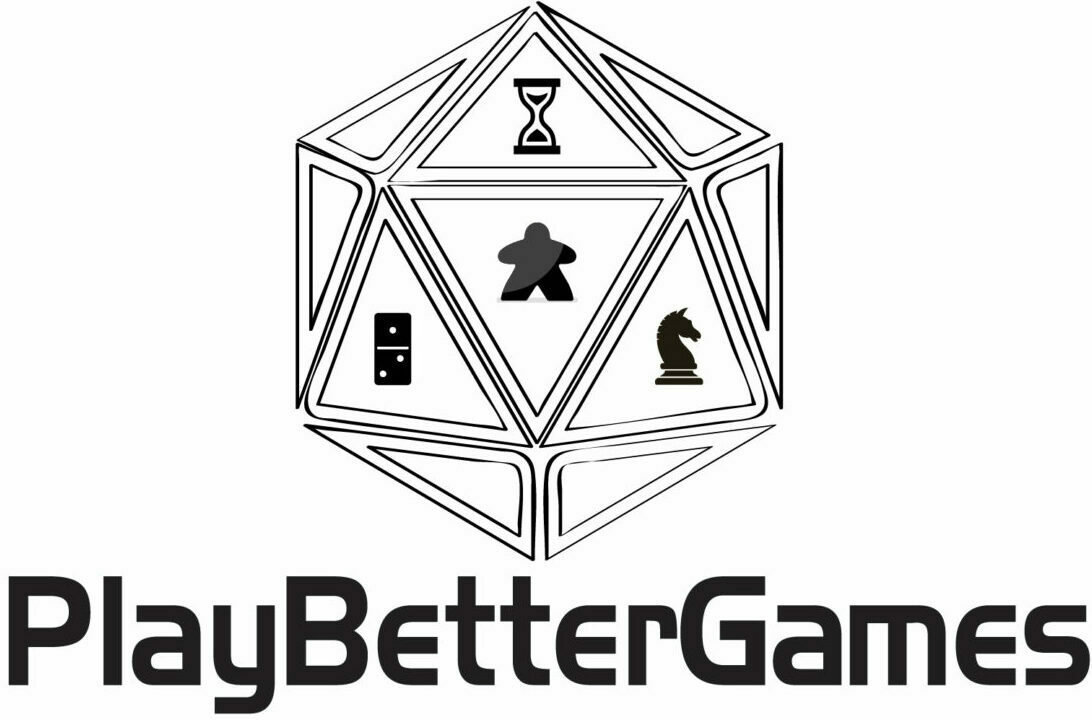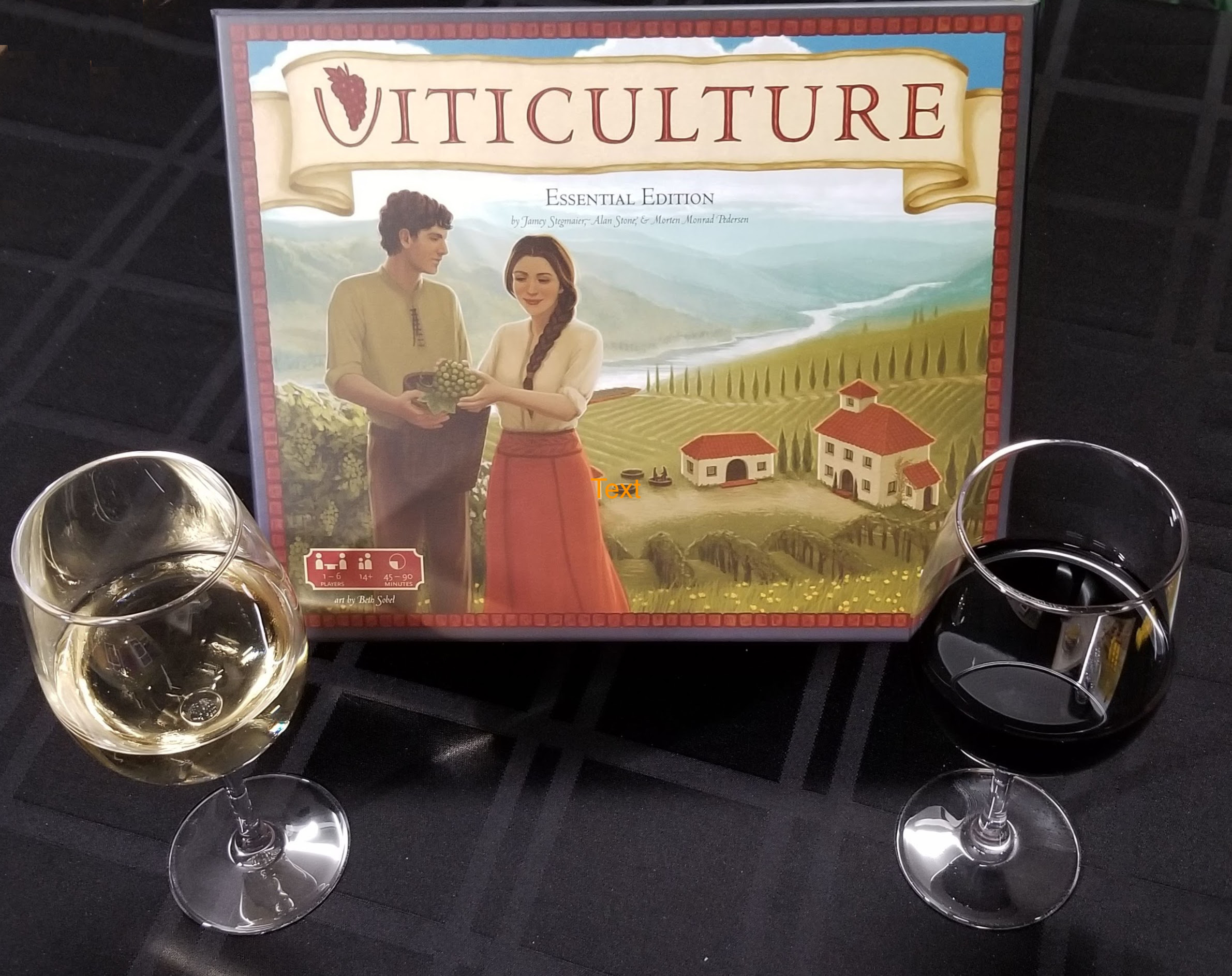Christin and I have lots of hobbies. In addition to our love of board games we also love to cook and to make and drink wine. When we heard there was a wine-themed board game we just had to try it out! Spoiler alert: it did not disappoint.
There is a lot to this game, it can seem overwhelming at first, especially if you’ve never played a worker placement game before.
Don’t worry, in this post, I’m going to walk you through the basics so you can get a feel for the mechanics of Viticulture and decide if it’s something you might like. This post will not be a replacement for the rulebook by any means.
That said, Stonemaier Games typically does a really good job with their rulebooks, so if you decide to give this game a try, they’ll have you covered.
In addition, I’ll link to some other resources across the web that will help get you started. Ready to see what it’s like to fulfill that dream of owning a vineyard? Just want to play a game and drink some wine? Either way, let’s jump in!
An Overview of the Viticulture Board Game
Viticulture is a worker placement game released by Stonemaier Games in 2013. In Viticulture, players are winemakers in old-world Italy trying to build their winery, make the best wine they can, and fill wine orders. The game can play up to 6 players but it is typically best with 3-4 players. Viticulture has a playing time of about 90 minutes (we typically get through a two-player game in about 45 minutes).
The game ends once a player reaches 20 victory points, so it’s a bit of a race to the finish. The main game board has spaces that depict the different actions a player can take; the color of the space denotes which season that action can be taken in.
The players each also have a smaller player board and wooden tokens they place on that board to signify different structures they have built in their vineyard. Some structures like a trellis or water tower are needed to plant certain types of grapes, while others like the tasting room will help them make more money.
To take an action you have to place a worker on an open action space. There are all kinds of things players can do, they can plant vines, harvest grapes, produce wine, sell their wine to various customers, interact with visitors and even train more workers so they can take more actions!
How to Play Viticulture
Each player starts the game with two regular workers, one grande worker, three empty plots of land, a small cellar, and one vine (Pinot Grigio). That’s it. No money, no other cards.
The game is played over a series of rounds with each round representing a year at your vineyard. During the summer and winter seasons, you’ll employ your workers in tasks while the autumn and spring seasons function more as clean-up phases.
What you do in each season is clearly labeled on the board which makes it very easy to make sure nothing is skipped.
Players will take turns placing their workers on various spaces around the board and taking the associated action. At any time a player can pass, but after doing so they can not place any other workers during that season. A player usually passes in the summer in order to save workers to play in the winter. You don’t get any of your workers back until the start of the next year!
A Look At Some of The Tasks (Actions)
Tasks are represented by circular spaces on the game board, next to each space there is text telling you which action you can perform if you place your worker in the space. The reverse side of the game board is the same, except it does not include this text, so if you’ve played a lot and want to just enjoy the artwork, you can flip the board over.
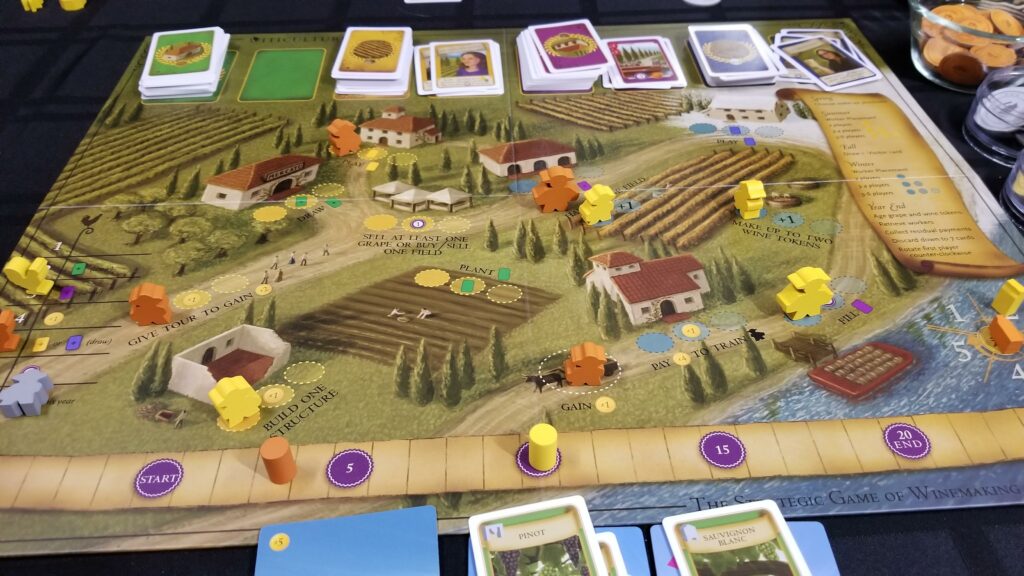
Players take turns placing workers and performing the actions associated with each location. If all of the spaces at a particular location are filled you can not take that action unless you use your Grande worker to perform it. The Grande worker can go to a location even if all of the spaces at that location are filled.
The number of spaces available at each location varies depending on the number of players. In a two-player game, there is only one space at each location. The board has a helpful guide to let you know which spaces you can use based on the player count.
Turn Order
In a worker placement game, often the first worker placed has a big advantage. All of the spaces will be available to the first player to place a worker. To balance this advantage, the game gives you a benefit for choosing to go later in the round. The different benefits are listed on the turn order track.
The game provides you with a green grape token to signify who the first player is, but that only signifies is who gets to choose their position in the turn order first. The first player chooses how early their workers will wake up by placing their rooster in one of the slots numbered 1-7. They then take the benefit listed next to that number. It could be extra money, an extra card, or an extra worker that they get for this year only.
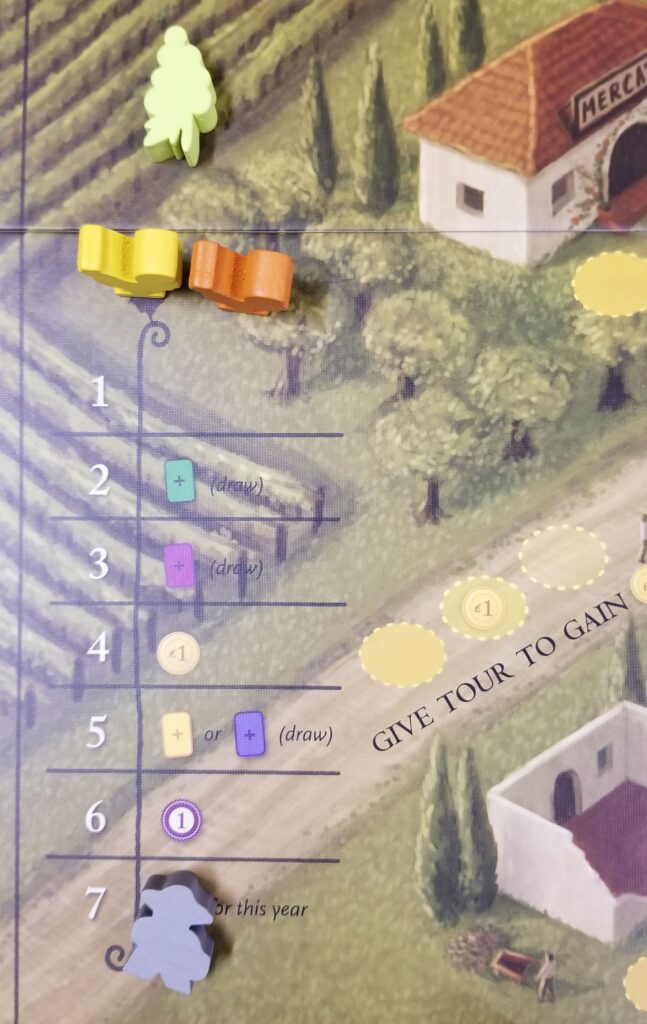
Once the wake-up order has been established it stays this way for the rest of this year. In every season, turns will be taken in this order. Once the round is completed (next spring) the first player token pass to the next player and the wake-up slots are chosen again.
Visitor Cards
Another way to take powerful action throughout the year is with visitor cards. One of the tasks you can take is to draw a summer visitor or a winter visitor. A visitor card provides you with an extra action or specific one-time benefit that you receive when you play them.
You have to spend another action to play the visitor card but do not neglect visitor cards. Workers and visitors both play important roles in your vineyard, and the visitors can really help you rack up points.
Building Structures
In the summer season, you have the option of building a structure; this is a common mechanic in this type of game. Once you have built a structure you typically unlock a new benefit or ability. For example, if you build your tasting room you can make more money when you give a tour, when you build a larger cellar you can store better wine etc.
Most worker placement games give you simple cardboard tokens to keep track of which things you have built, but Viticulture provides you with nice wooden tokens for this. When you have built a structure, place the matching token on your player board.

Harvesting Grapes
When you take the harvest grape action, you can harvest one of your fields. Add together the values for each color grape, and use a glass bead to add that value of grape to your crush pad.
For example:
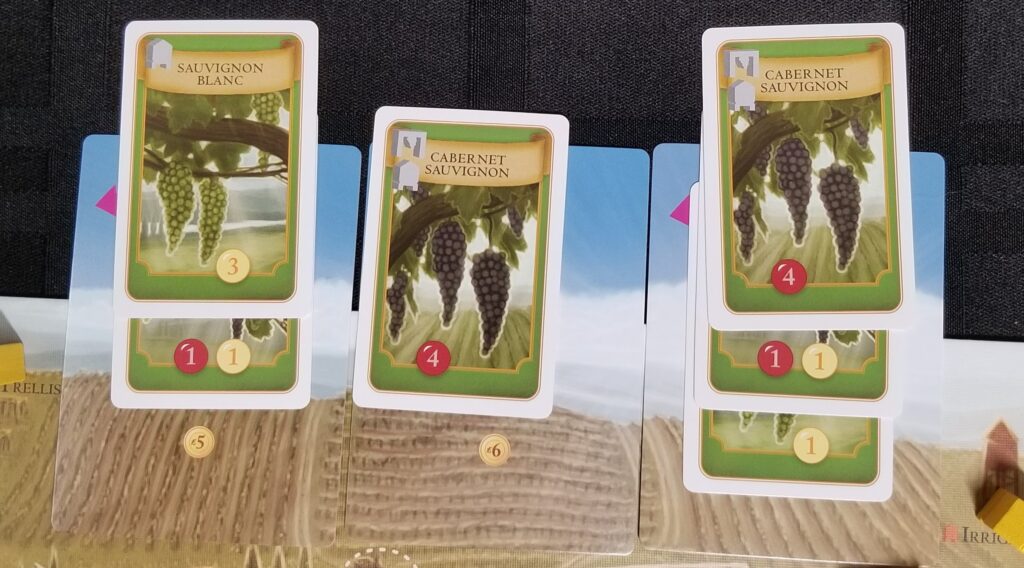
If you were harvesting the right-most field, you would create a level 5 red grape and a level 2 white grape.
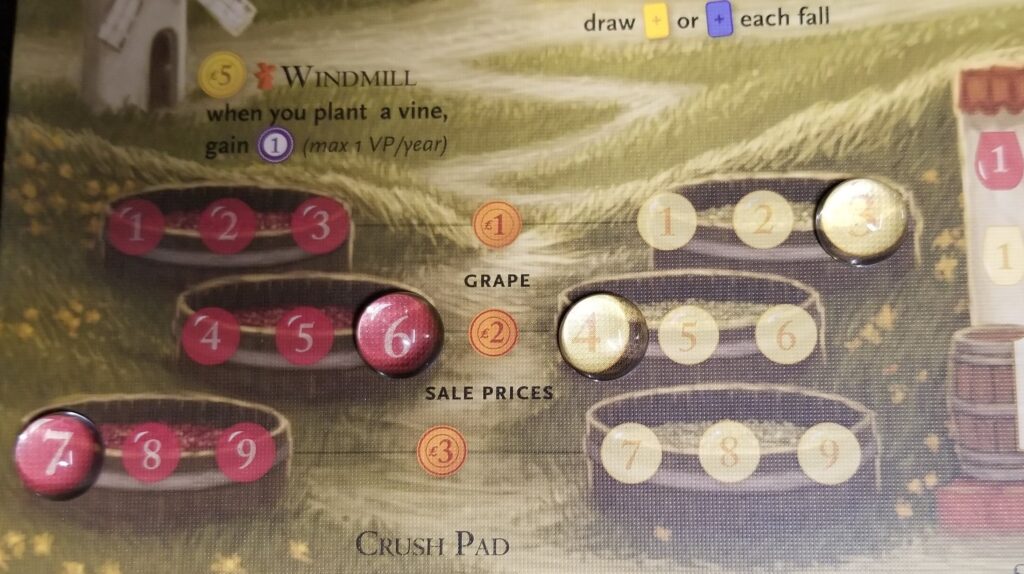
You would add a grape token on the red 5 and the white 2 on your crush pads.
Making Wine
When you make wine you do it in a very similar way. You can combine the values of any of the grape tokens you have and create a wine that has that value. Using the crush pad pictured above, you could use your 3 and 4 white grape tokens to create a white wine with the value of 7.
You can also create blush and sparkling wines by combining red and white grapes. You can not make wines with a level greater than 3 until you’ve built the appropriate cellar.
Aging Your Wine and Grapes
Add the end of each year you age your inventory. You get to move all of your grape tokens and all of your wine tokens up to the next number. You can’t put more than one grape token or wine token on a space; if the spaces above are filled the tokens don’t move.
Also, the small cellar that you start with can only store wines up to a value of 3. You’ll need to build your medium and large cellars to age wine past that.
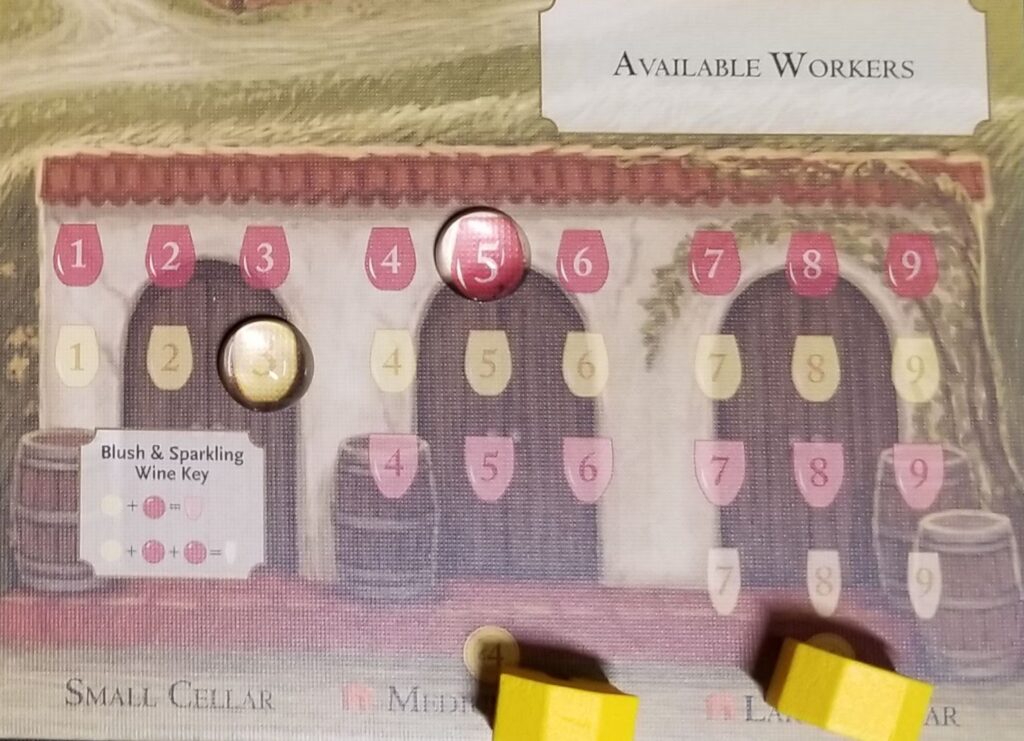
Filling Wine Orders
There’s no point making all of this wine if you can’t sell it, which you do by filling wine orders. Each wine order card tells you the type of wine and the minimum vintage you must sell to complete the order. Not only do you receive victory points for completing wine orders, you also receive residual income every round going forward.
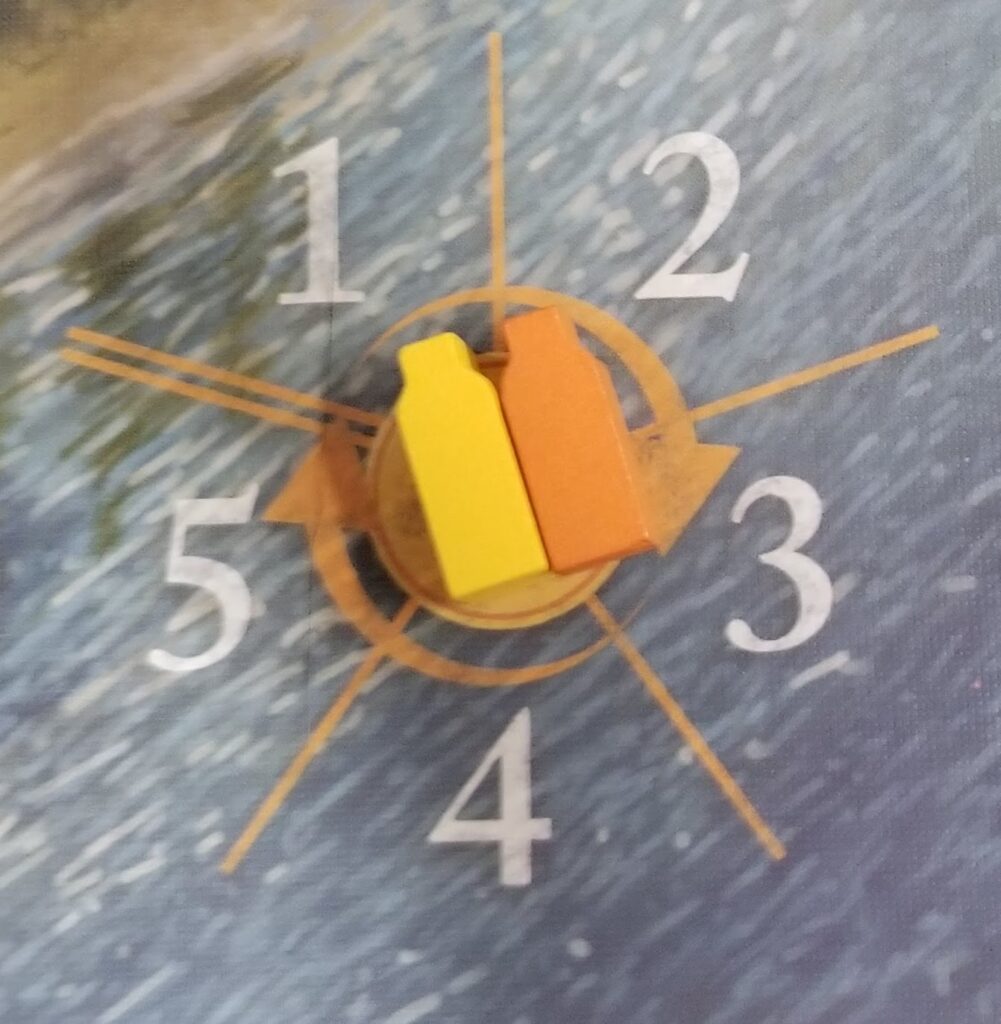
The idea here is that you now have some repeat business. Move your wine bottle to the next number on the outside of the residual income track. You now get to take that amount of Lira at the start of each year.
End of Game
At the end of each year check the Victory point track. If someone has reached 20 points or more, the game is over.
You’ll also notice that the lowest number on the victory point track is -5. This is because there are visitor cards that allow you to pay victory points to receive some benefit. You can do this even if it causes you to go into the negative, but you can’t go lower than -5.
Why You Should Play Viticulture
Viticulture is a great game for those who enjoy worker placement games or games with an agricultural theme. The game is also relatively easy to learn. Even though there are a lot of possible tasks, and a lot you can do, the board clearly lays everything out so it’s easy to follow.
That said, there are a lot of decks of cards to use and manage in addition to the worker placement aspect of the game. I probably wouldn’t recommend it as your first ever game in this genre, but if you’ve played something like Kingsburg before, you should not have trouble with this one.
Viticulture offers a lot of replayability thanks to its various card decks, which offer different combinations of actions from the visitors and wine orders to fill. Also, people REALLY like the expansions and they add to the replayability of the game.
Viticulture is one of those games where you really have to think about what you’re doing in order to be successful. There are a lot of different ways to play the game, and each one offers its own unique challenge.
If you’re looking for a fun and challenging board game to play with friends, Viticulture is definitely worth checking out!
Understanding the Viticulture Editions
Since its release nearly ten years ago, Viticulture has seen a number of expansions and new editions. Some of these editions have come and gone, and it can get a little confusing to know what’s included in each. I’ll list them all here, that way even if you come across an older version on eBay you’ll know what you can expect.
Viticulture (1st edition): This is the original version of the game, and unless you find it very inexpensively I wouldn’t bother picking it up. The game has gotten much better with each iteration and this edition of the game is missing some mechanics that are considered essential now
Tuscany Expansion: The original Tuscany expansion, which came out the year after the game was released, introduced around a dozen modules that could be mixed and matched adding more depth to the original game. It also included metal coins to replace the cardboard Lira tokens. This is out of print now, but if you can land an old copy of it cheap, it’s worth picking up for the metal coins alone. You can still get the metal coins from Stonemaier Games, they usually run around $30.
Viticulture (2nd edition): The second edition of viticulture made some much needed changes. The biggest difference in the second edition of the game was the addition of the Grande Worker. Without the grande worker, there were times when you would just get stuck without a task you could complete.
The grande worker alleviated this by allowing a one-per-round ability to repeat a task taken by another player. This small change had a big impact on gameplay. The second edition also included a revised rulebook, updated artwork, and some other small changes.
Viticulture Essential Edition: This is where we are today. Viticulture’s third edition is simply called the Essential Edition. This is what you will find if you search for the game today, and it’s the edition I would recommend you get. In this edition, they took some of the most popular modules from the Tuscany Expansion and included them with the base game. This is the edition we have played and it’s great.
Tuscany Essential Edition: This is an expansion to the base game, it can not be played on it’s own – you’ll also need one of the editions of Viticulture. Just like with Viticulture Essential Edition Stonemair has taken the most popular parts of the original Tuscany Expansion and included them here. This expansion adds expanded player boards and structure and worker cards which give you additional ways to score points. A lot of players really like this expansion and feel that it rounds out the original game.
Visit From Rhine Valley: This is not so much an expansion as it is an alternate set of visitor cards that you can use. These cards give you benefits that help improve your wine production instead of giving you victory points. This results in a much more strategy-focused game and eliminates the chance of someone running away with the game based on some lucky card draws. I haven’t played with this yet, but I will absolutely be picking this up, it was very well received by fans of the game.
Moor Visitors Expansion: This expansion also adds new visitor cards, but these are meant to be added to the visitor decks of the base game, not to serve as a replacement for them. The general consensus among Viticulture fans seems to be that Rhine Valley is the better expansion to use.
Is Viticulture Worth the Money
I really like worker placement games, so I enjoyed this one a lot. Winemaking is also a theme that resonates with us because it is something that we also enjoy doing. Christin and I played Viticulture twice on the weekend we got it.
It is a bit more complicated than other worker placement games we have played, so if you’ve never played a worker placement game before you may want to start with something like Kingsburg or Lords of Waterdeep.
All of that said, I think this was a great game that is very replayable. The visitor cards offer interesting effects and there are multiple strategies you can try on future play-throughs.
Stonemaier games is also known for making games with high-quality components. Many worker placement games like this would give you little cardboard tokens to designate which buildings you have constructed. Viticulture has a different wooden piece for each building, which is a nice touch.

The coins are cardboard, but will still hold up for a long time. I do plan to eventually get the metal coins that Stonemaier offers for this game, but that’s by no means a necessity.
Overall, I think Viticulture is well worth the money for the quality of the game you’re receiving and the hours and hours of playtime you’ll likely get out of it.
Can you Play Viticulture Online?
You can play Viticulture online on BoardGameArena.com. It is in their premium tier, so you’ll either have to be a paid member or play with a paid member in order to play it.
There is also a digital version available on Steam. My physical copy of the game came with a coupon for 25% off the Steam version, so if you think you’re going to get both, get the physical version first and you may save some money on the digital edition.
Can you Play Viticulture Solo?
There is a solo variant for this board game, and it’s included in the Viticulture Essential edition. I’m not big on solo variants, but they are becoming popular, and if I were going to try one, it would be this one. When I do I’ll add my thoughts here.
Video Instructions for Playing Viticulture
Rodney over at watch it played has an excellent tutorial for learning how to play Viticulture. We suggest you start here and then use the rulebook for reference.
Final Thoughts on Viticulture
Whether you’ve always had a dream of owning a vineyard, or just like drinking wine Viticulture is a great game to try out. It does a great job of implementing the work placement mechanic and layers on other facets which give you multiple potential paths to victory. It is even possible to win the game without selling any wine.
The layers of the game make is slightly more complex than other worker placement games, but if you’re willing to take the time to learn it, you will be rewarded with a great gaming experience. I hope you give Viticulture a try! Happy Gaming!
